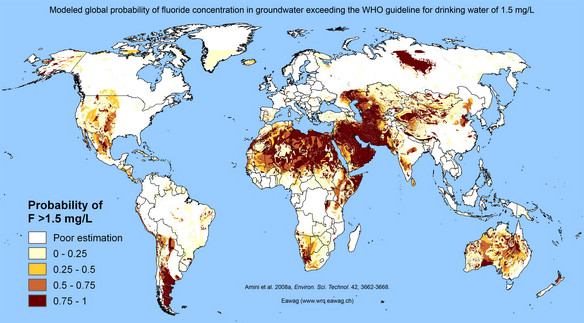THERE CAN BE TOO MUCH FLUORIDE IN WATER
Fluorosis problems around the world and how to check your levels
TL;DR summary:
While small amounts of fluoride in water are beneficial, there can also be too much fluoride in water.
Most occurrences of too much fluoride in water are natural, due to geology. And the truly dangerous situations of unsafe fluoride levels in the world occur in countries like India, China, and Ethiopia.
In the U.S., too much fluoride in water is rare. U.S. science agencies work together to make sure fluoride in water from drinking water treatment plants is at safe levels … 0.7 ppm ideally. But if a local water source is naturally higher than the ideal, water treatment plants strive for a goal of no more than 2 ppm in order to avoid kids getting severe dental fluorosis on their teeth. If they can’t reach that goal, they’re mandated to advise you to seek a different water source for your kids, and they’re mandated to have no more than 4 ppm in the water for everyone’s safety from skeletal fluorosis. As a result, we have no problems with skeletal fluorosis in the U.S. from too much fluoride in water. There is science indicating that 4 ppm may still be a little high for drinking water over the long-term, though, and science agencies are considering whether the mandated upper safety limit should be lowered to something closer to 2 ppm.
You can check with your local water agency to be sure of your levels. Water treatment plants also mail each customer a yearly report on water quality, which will contain information on fluoride. Or if you have private well water, you need to do testing yourself. Science agencies recommend testing well water every three years.

Fluoride is like any other vitamin or nutrient. It is beneficial at the right amounts, but too much can be bad for you.
The most common source of way-too-much fluoride is from water sources that naturally have high levels of fluoride – due to geology.
So fluoride poisoning is as natural a process as fluoride preventing tooth decay is (which is often called Nature's way to prevent tooth decay). Eesh, sometimes nature is out to get us!
Truly dangerous and poorly controlled levels of high fluoride in water occur outside of the United States.


Top picture is from Guri, a village in Rajasthan in Northern India, where fluoride levels are commonly greater than 10 ppm, and reach as high as 24 ppm … which is 34 times higher than the optimal amount of 0.7 ppm. (Photo by JP Hamon, CC BY 2.0)
Bottom map shows a global model of the probability that fluoride in groundwater exceeds safety levels due to natural geologic conditions. (Map is from Amini et al. 2008, Environ. Sci. Technol. 42, and the gapmaps.wiki project).
Parts of China, India, and Northern/East Africa are the most affected. Several countries in the Middle East – such as Iraq, Iran, and Pakistan – also have high levels.


Top picture is from Guri, a village in Rajasthan in Northern India, where fluoride levels are commonly greater than 10 ppm, and reach as high as 24 ppm … which is 34 times higher than the optimal amount of 0.7 ppm. (Photo by JP Hamon, CC BY 2.0)
Bottom map shows a global model of the probability that fluoride in groundwater exceeds safety levels due to natural geologic conditions. (Map is from Amini et al. 2008, Environ. Sci. Technol. 42, and the gapmaps.wiki project).
Villages in China have had levels of 8 ppm and higher – that’s 11 times the recommended amount for healthy teeth. In East Africa in the Great Rift Valley, levels of 10 ppm and higher are common – and some lakes in Africa have been recorded as high as 26, 177, and 2800! The recommended amount for healthy teeth is less than 1 – so these levels in other parts of the world are really … incredibly high.
Skeletal fluorosis is a substantial risk in these regions where there are such high fluoride levels. And cases of severe dental fluorosis in these parts of the world commonly reach levels of intensity that go far beyond the cosmetic concern that dental fluorosis is in the U.S.
In recent years, there have been some occasional odd American cases of skeletal fluorosis … but not from water. Instead these cases are from drinking tea that is high in fluoride … and drinking it quite excessively …
Like the woman from Michigan who drank a pitcher of tea steeped with 100 bags every day for 17 years … or the lady from Illinois who had been drinking two gallons of instant tea every day for nearly 40 years … or the woman from Georgia who had been drinking at least one and often two gallons of orange pekoe tea every day for over 30 years. All these ladies got skeletal fluorosis that gave them pain, stiffness, and other symptoms that affected their lives. Remarkably, most symptoms resolved when they simply stopped drinking all that tea. So … um … seriously, ladies, maybe don’t drink two gallons of tea every day for decades, k? :)
As we mentioned, severe dental fluorosis in America is rare, too. It is so rare that researchers have trouble getting precise estimates, but we know it is less than 1%. By difference, it is only 0.1% in the most recent analyzed published survey’s graph, and it is reported as only 0.25% in this presentation. When severe dental fluorosis does occur in the U.S., in most cases, it is not actually very severe and is mostly a cosmetic issue. Severe dental fluorosis in the U.S. is so tame that when researchers started working on truly endemic fluorosis in countries like Tanzania, researchers had to develop an entirely new rating system with 4 more categories of severity.
But hold up … not quite so fast … As you can see on the map above, the U.S. does have plenty of instances of naturally high levels of fluoride in water. So we do need to be mindful of it here, too. To help maintain the great progress we’ve made in preventing severe dental fluorosis and keeping skeletal fluorosis from being a problem in this country, we need to be aware of too-high levels. It’s a good idea to know the basics of our country’s systems for ensuring safety from water sources with naturally high fluoride. And we all need to know whether we need to do any research or testing on our family’s water.
Who’s who in protection from excess fluoride in water
The folks who ensure safety from water sources in the U.S. with naturally high fluoride include the doctors and scientists working at the U.S. Centers for Disease Control and Prevention (CDC) and the U.S. Environmental Protection Agency (EPA), as well as local water operators. In addition, the Food and Drug Administration makes sure bottled water has safe levels.
CDC and EPA have distinct but complementary roles. With EPA’s input, CDC decides the recommended ideal amount of fluoride in water – the amount that is best for teeth. That’s the 0.7 ppm level we discussed in our article Fluoridated water has just a little fluoride. It’s the optimal amount CDC recommends that’s neither too high nor too low. It’s up to local communities and their water districts to then decide whether to adjust fluoride in water to this recommended amount.
EPA decides maximum safety levels. Currently, EPA has two safety levels: 4 ppm is a mandated level and local water companies are not supposed to provide drinking water with fluoride at 4ppm or above. 2 ppm is a level that is recommended as the maximum for kids to drink, but 2 ppm isn’t mandated.
Drawing water from sources where fluoride levels are less than 4 ppm protects Americans from skeletal fluorosis – this safety level has done an excellent job at making sure this bone disease is not a common crippling problem for Americans like it is in too many other parts of the world.
EPA has the lower recommended level of 2 ppm as a secondary goal for drinking water – in order to reduce the risk of kids developing severe dental fluorosis. If babies, toddlers, and kids drink water with fluoride between 2 and 4 ppm, then kids may get too much fluoride as their teeth are developing – especially if kids are also eating toothpaste when they aren’t supposed to. The dental fluorosis at these levels of fluoride can cause white spots and streaks, and in more severe cases, brown stains or pitting in the teeth.
So EPA recommends that drinking water treatment plants strive to keep water below 2 ppm.
But EPA does not currently require water districts to keep fluoride levels below 2 ppm. There are a few reasons for this. Removing fluoride from water can be prohibitively expensive for local communities. EPA has also considered most dental fluorosis that forms between 2 ppm and 4 ppm to be a cosmetic issue and not a functional issue. And dental fluorosis only develops during formation of the teeth during childhood – it doesn’t continue to form during adulthood. So what EPA does require is that water treatment plants send you notices if your water is between 2 and 4 ppm – to warn you that a different source of water would be best for your babies, toddlers, and kids.
You’re not going to get any notifications if you’re on well water, though! EPA and CDC scientists are concerned about fluoride safety for households that use well water – because well water can have levels of fluoride that are above any of these safety standards. But they don’t have the authority or resources to regulate all the small private wells that serve 14% of Americans, nor the 1% of those wells that have high fluoride levels.
Your state may have lower upper limits, too. States are free to mandate more stringent requirements than the EPA sets.
Is 4 ppm adequate as a requirement for protecting us from naturally high fluoride levels? Or should the mandated upper limit be closer to 2 ppm?
Another thing we think you need to know about our safety systems to make sure fluoride in water isn’t too high is that EPA has been debating for years about whether to make 2 ppm (or some other value that’s close to 2 ppm) the mandated maximum.
The debate about whether to lower the level down to 2 ppm partly comes down to genuine disagreement among scientists and researchers about how big a deal severe enamel fluorosis is, in the few U.S. communities with water that’s close to 4 ppm. Particularly because these communities may object to the expense of removing fluoride from their water source or finding an alternative water source. Health experts disagree on whether it constitutes a merely cosmetic condition or whether it constitutes an adverse health impact. And EPA isn’t so into mandating pretty teeth. EPA is in the business of protecting health. If severe enamel fluorosis is just making teeth less pretty, then it’s not really EPA’s main thing to worry about, especially if it can be prevented by the simple action of parents providing children an alternative to tap water until their permanent teeth have finished developing. If severe enamel fluorosis is an actual health impact, it is more in EPA’s job description to research and develop new policies to protect the health of our kids’ teeth.
In the early 2000s, EPA commissioned the National Academies of Sciences to put together a panel to review the question of whether EPA should consider lowering the goal for the mandated level. In 2006, at the conclusion of the panel’s work and at the publication of their report, ten of 12 panel members agreed that severe enamel fluorosis seen at levels close to 4 ppm constituted more than a cosmetic condition. Ten of the 12 agreed that severe dental fluorosis is indeed an adverse health impact – because this type of fluorosis can result in enamel being missing. The pitting we mentioned above that’s a characteristic of some severe enamel fluorosis are little spots where the enamel isn’t there, so that’s arguably more than merely cosmetic.
Furthermore, all 12 members agreed that EPA should lower the goal for the mandated level – the two in disagreement on cosmetic vs. health impact still felt the cosmetic concerns are important enough that we should consider a lower mandated safety level. And the committee all thought that we would be even safer from the possibility of skeletal fluorosis and broken bones in old age if the upper limit was a little lower, too.
Well, it’s 12 years later, and EPA has not changed the level – what gives? See, the National Academies of Sciences panel didn’t pick a new level … it took them a couple years just to all agree that EPA should work on picking a new upper limit. EPA would still need to do a butt load of work to get to agreement on what a new upper limit would be and whether the panel was even right that a new upper limit is warranted.
In-depth science reviews, analyses, and maybe new data collection on fluoride is some of the work involved – and EPA has done quite a bit of that work since the National Academies of Sciences panel. The effort would also take tons of public comments from scientists, organizations, members of the public, and probably local water operators and local communities for whom a mandated level of 2 ppm would be incredibly difficult and expensive for them to pull off … when maybe those communities feel it is working pretty well for moms and dads to use different water for kids. EPA also has a huge list of other things to do, especially with other higher priorities in drinking water safety (hello, lead in Flint’s water! hello, lead in water across the country! hello, 23% of private wells that have safety concerns other than fluoride, including radioactive substances like radon and uranium!). While EPA scientists are still looking at it, and would love to get to work on it, naturally high fluoride levels that maybe put some kids at risk of some brown stains and pitting that a dentist could fix just isn’t as big of a problem as other things EPA scientists think we also need to focus on for water safety.
Ways to figure out the levels in your water & what those levels mean for your family to do list
So now that you know all the basics of these different benchmarks for fluoride in water, how do you go about double checking what the levels are in your family’s water?
If you are on a municipal water source, there are a few different options to track down your levels. You can:
- Contact your water company or look on their website for whether your water is fluoridated, and if so, whether it is to the 0.7 ppm level.
- Track down your water operator’s Water Quality Report (may also be called a Consumer Confidence Report). You can typically find these on your water operator’s website and they mail them to you every year. The report will have a table of water quality parameters, including fluoride levels.
- See whether CDC’s MyWatersFluoride system has your state and your local water source in their national database of fluoride levels from drinking water treatment plants.
If you are on private well water, then you’ve got to get it tested. Note that private well water might be a bit larger than just an individual well. Private wells may have up to 15 connections serving 25 people. State agencies typically have some good guidance on how to get it tested.
Now once you know your level, what does it mean?
If your water is fluoridated at 0.7 ppm, you’re in great shape. This level is good for fighting tooth decay. And there is zero – absolutely no – severe enamel fluorosis from water fluoridated at 0.7 ppm. There’s zero risk of skeletal fluorosis, too. (Kids could still get severe enamel fluorosis from swallowing large amounts of toothpaste or inappropriate fluoride supplements, though – more on toothpaste in this article and more on supplements in this article – and uh, ladies, again, watch it with the frickin’ tea!)
If your water is below 0.7 ppm, there’s again no risk of severe enamel fluorosis or skeletal fluorosis, but everyone in the family may have higher risk of cavities. There’s not enough fluoride to be as effective at counteracting acid attacks and remineralizing your enamel. For kids, you’ll want to consider supplements.
If your water is above 0.7 ppm but below 2 ppm, most health and safety experts agree that water is safe for everyone in the house in terms of health. But your kids’ teeth may not be so secure in terms of appearance. As we all know from all those ads for tooth whitening, a lot of us are very concerned about the appearance of our smiles. So you might feel differently as a mom about whether a fluoride level in this range is ok for your kids. As you go from 0.7 to 2, your kids will get more of two things. First thing is that they’ll be more likely to get very mild, mild, and moderate forms of enamel fluorosis. Very mild and mild fluorosis (white spots and streaks) will be more likely as you go from 0.8 to 0.9 and on up to 2 ppm. And then as you get closer and closer to 2 ppm, they’ll be more likely to get moderate fluorosis, too (which could involve some brown stains) and you’re getting into territory where severe enamel fluorosis may be possible (where some small pitting may happen). The tradeoff here is the second thing they’ll also be more likely to get at some of these slightly higher levels of fluoride in water: even better protection from tooth decay! We talk more about this tradeoff between aesthetics/fluorosis and greater cavity prevention in this article, so that’s one you’ll definitely want to read if you’ve got water between 0.7 and 2 ppm.
Another thing we think you need to know for your family, especially if your water is at about 2 ppm, is that the World Health Organization (WHO) has a little bit lower of an upper limit that they advise. WHO recommends that fluoride in water should be no higher than 1.5 ppm for everyone. Likewise, some of the research EPA has been doing in recent years suggests that the upper limit to avoid most severe enamel fluorosis may be more around 1.8 or 1.9 ppm. The newer work EPA has been doing while deciding whether to lower the upper limit or not included re-analyzing some of the key literature with updated information and statistics. EPA is still assessing this re-analysis and how good it is, but they estimated that severe enamel fluorosis may occur in 1 out of every 200 children who drink water with a fluoride level of 1.87 ppm over their childhood.
What everyone agrees on for sure is that if your water is between 2 ppm and 4 ppm, you definitely want to do something to address it for your kids. Using a different water source for drinking and filtration of drinking water are a couple options, and you’ll need to do some more research and consultation with your doctors, dentists, and local community resources to determine your options.
You might even want to do something for yourself, too, if your levels are close to 4 ppm. The National Academies of Sciences panel did also think a lifetime of drinking 4 ppm might increase your risk of breaking a hip or another bone in old age, and hey, why not go a little lower if you can, to make sure you’re that much less likely to be drinking from a level that causes skeletal fluorosis. If your water is above 4 ppm, though, you definitely need to take action to drink from a different source or install filtration that is effective for fluoride removal for everyone in the family.
Knowing your level is also important for deciding whether to talk to a doctor or dentist about fluoride supplements. Whether your kid should be taking any fluoride supplements totally depends on how much fluoride is in your water, so be sure to dive in to the relationship between fluoride supplements and water as well, which you can do here in the next article in our series on what moms ought to know about fluoride.

